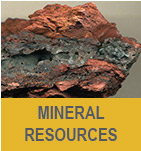Wyoming Minerals
 The diversity of Wyoming’s minerals has been an anchor for the state’s economy in the past and will continue to contribute to its development.
Our energy minerals (coal, uranium, and oil and gas) are known worldwide, as is our state gemstone, Wyoming Jade.
However, metals and industrial minerals
are also prominent in Wyoming. Modern exploration in Wyoming includes base and precious metals, gemstones, and industrial and critical minerals.
The diversity of Wyoming’s minerals has been an anchor for the state’s economy in the past and will continue to contribute to its development.
Our energy minerals (coal, uranium, and oil and gas) are known worldwide, as is our state gemstone, Wyoming Jade.
However, metals and industrial minerals
are also prominent in Wyoming. Modern exploration in Wyoming includes base and precious metals, gemstones, and industrial and critical minerals.
Early discoveries and development of gold mines near South Pass in the mid-1800s helped Wyoming become a territory and then a state.
Copper mining that began in the late 1800s peaked in the early 1900s when the Ferris-Haggarty mine in the Sierra Madre was one of the
top 30 copper mines worldwide. After the mine’s closure in 1908, Wyoming no longer was a significant copper producer, although a
large resource still exists in that mine. Exploration in the 1950s through the 1980s identified substantial copper resources at several
locations in the Absaroka mountain range, and in the early 2000s, exploration in the Silver Crown mining district in the Laramie Mountains
expanded a known copper resource.
![Blue azurite and black Tenorite in the Jurassic-Triassic Nugget Sandstone from the Griggs mine in the western Wyoming thrust belt. [Credit: Wayne M. Sutherland, WSGS] azurite and tenorite copper ore](../images/minerals/azurite-and-tenorite-griggs-mine.jpg) Iron mining began near Rawlins in the 1870s, in the Sunrise area in 1898, and in the Atlantic
City Iron Mine near South Pass in 1962. The last reported production from Rawlins was in 1945.
Iron mining ceased at Sunrise in 1980 and at South Pass in 1983, although both mines still host significant iron resources.
Iron mining began near Rawlins in the 1870s, in the Sunrise area in 1898, and in the Atlantic
City Iron Mine near South Pass in 1962. The last reported production from Rawlins was in 1945.
Iron mining ceased at Sunrise in 1980 and at South Pass in 1983, although both mines still host significant iron resources.
![Mining in 2008 at OCI's underground trona mine in the Wilkins Peak Member of the Eocene Green River Formation. [Credit: Wayne M. Sutherland, WSGS] mining](../images/minerals/underground-trona-mine.jpg) Industrial minerals such as bentonite (first described in Wyoming), gypsum, aggregate, crushed stone, chemical-grade limestone,
decorative stone, and trona, play a continuing role in the state’s economy. In fact, Wyoming’s trona resources, an estimated 127
billion tons, are the largest in the world.
Industrial minerals such as bentonite (first described in Wyoming), gypsum, aggregate, crushed stone, chemical-grade limestone,
decorative stone, and trona, play a continuing role in the state’s economy. In fact, Wyoming’s trona resources, an estimated 127
billion tons, are the largest in the world.
Critical minerals, such as rare earth elements and platinum group elements, have either been historically mined in Wyoming or are currently being explored and developed. Wyoming
is home to many potential critical mineral deposits, which could have a role in the state's economy in the future.
Wyoming also hosts a wide variety of gemstones and lapidary material that include diamonds, jade, iolite, agates, and petrified wood.
These precious and semiprecious stones and lapidary material have attracted both amateur rock collectors and commercial interests
from across the nation and around the world.
The WSGS recently launched an online compilation of mines and mineral occurrences in Wyoming (click on icon at top right).
The Mines and Minerals Map of Wyoming provides mine locations, geology, historical information, mineralogy, and chemical analyses for a wide variety of mines across the state.
The interactive map was developed to promote greater awareness and understanding of the state’s mines and minerals resources. Although the map
is a work in progress, the data shown will help planners, prospectors, researchers, and individuals find mining and geologic information.
The WSGS has published a report on the relative abundance of elements spanning the state.
Regional-Scale Geochemical Investigations from
Legacy Rock and Sediment Datasets describes how spatial statistics and a classification scheme were used to document areas with known
mineralization, missed mineralization, and potential mineralization throughout Wyoming.
Contact:
Patty Webber, patty.webber@wyo.gov